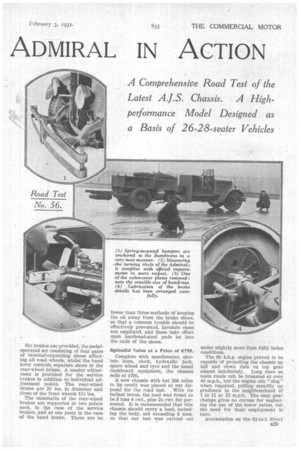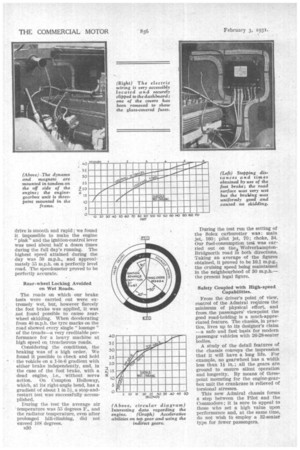THE
Page 46

Page 47

Page 48

If you've noticed an error in this article please click here to report it so we can fix it.
ADMIRAL IN ACTION
A Comprehensive Road Test of the Latest A.J.S. Chassis. A High performance Model Designed as a Basis of 26-28-seater Vehicles
ATHIRD model has now been added to the range of passenger-carrying chassis produced by A. J. Stevens and Co. (1914), Ltd., Walsall Street, Wolverhampton. The two types which have already attained considerable popularity are, of course, the Pilot, for 26-seaters, with normal or forward control, and the Commodore, a forward-control type for 32-seater vehicles. The new machine somewhat follows the Commodore in detail design.
The new model is designated the Admiral, and is a normal-control machine for 26-28-seater duty. It is intended to give a high degree of road performance on top gear so as to form a suitable foundation for long-distance luxury coaches. How well it performs its duty will be gathered from the succeeding paragraphs.
Important Dimensions of the • Chassis.
Before describing the performance in detail it will be well to outline the leading features of the new type. It has a wheelbase of 16 ft. 2 ins., a frame height of 25i ft. (laden), an overall length of 24 ft. 5 ins., a body space of 20 ft. 4? ins., track 5 ft. .101 ins., overall width 7 ft. 11 ins. (over the hub caps), and the maximum frame width is 3 ft. 3i ins.
Behind the dash the frame is downswept to give a low loading level, and the rear overhang behind the upswept portions continues at the same height. The maximum frame depth is 8 ins. Semi-elliptic springs are used at both ends. The front axle is in nickel steel and of Hsection. The swivel arms are also in nickel steel and carry roller-bearing hubs. An underslung worm is carried in the forged-steel casing of the rear axle, the half shafts being of the fully floating type. The disc wheels, which are secured by 10 studs in each case, carry 36-in. by 6-in, pneumatic tyres, those on the rear wheels being dual. Steering is by cam-and-roller mechanism in conjunction with a 19i-in, wheel, above mrhich are controls for the slow-running Adjustment and the magneto. Provision is made for coil ignition if desired, the distributor drive being taken vertically from the camshaft, up through the cylinder head.
n28 Unit construction for the engine and gearbox is adopted. The power unit has six cylinders and is rated at 36 h.p. (R.A.C.). Further details are given in the accompanying panel. On the near side are located all the valves, access to them being gained through three detachable cover plates. The cylinder head, which is, of course, detachable, is of the Whatmough type. The buttended inlet pipe contacts with the exhaust manifold for a portion of its length, thus giving a hot-spot effect. The crankcase is internally ribbed to give additional strength and carries the four main bearings in its upper portion. The camshaft runs in five bearings. The distribution drive is by means of helical gears and the valves are operated through mushroom tappets, which are, of course, adjustable.
Lubrication by Submerged Pump in the Sump.
Lubrication is by means of-a submerged-type pump situated in the sump ; the capacity of the latter is over three gallons. The filler is very accessibly located at the front end of the engine, level with the fan hub. Behind the fan is a centrifugal pump, the drive for the two being taken through a belt. On the off side of the engine are the dynamo and magneto in tandem, whilst the carburetter is on the near side and is fed with fuel by an Autovac tank. The main tank is on the off side.
A stop is provided for the single dry-plate clutch which carries the power to the four-speed gearbox, above which is mounted a ball-type change-speed lever. The speedometer is driven from the gearbox, and a power take-off is provided for a mechanical tyre pump. Between the gearbox and the steady bearing of the propeller shaft is a shaft with a disc-type universal joint ; on the secondary shaft Hardy Spicer joints are employed. The steady bearing is carried in an insulated trunnion. Six brakes aye provided, the pedaloperated set consisting of four pairs of internal-expanding shoes affecting all road wheels, whilst the hand lever controls separate shoes in the rear-wheel drums. A master adjustment is provided for the service brakes in addition to individual adjustment points. The rear-wheel drums are 20 ins, in diameter and those of the front wheels 151 ins.
The camshafts of the rear-wheel brakes are supported at two points each, in the case of the service brakes, and at one point in the case of the hand brake. There are no fewer than three methods of keeping the oil away from the brake shoes, ' so that a common trouble should he effectively prevented. Involute cams are employed, and these take effect upon hardened-steel pads let into the ends of the shoes.
Splendid Value at a Price of £.795.
Complete with speedometer, electric horn, clock, hydraulic jack, spare wheel and tyre and the usual dashboard equipment, the chassis sells at £795.
A new chassis with but 266 miles to its credit was placed at our disposal for the road test. With its ballast boxes, the load was found to be 3 tons 4 cwt., plus 2/ cwt. for personnel. It is recommended that this chassis should carry a load, including the body, not exceeding 3 tons, so that our test was carried out under slightly more than fully laden conditions.
The 90 b.h.p. engine proved to he capable of propelling the chassis up hill and down dale on top gear almost indefinitely. Long rises on main roads cah be breasted at over 40 m.p.h., but the engine can "slog" when required, pulling steadily up gradients in the neighbourhood of 1. la 11 at 15 m.p.h. The easy gear change gives no excuse for neglecting the use of the lower ratios, but the need for their employment is rare.
Acceleration on the 61-to-1 direct 3329 drive is smooth and rapid ; we found it impossible to make the engine " pink " and the ignition-control lever was used about half a dozen times during the full day's running. The highest speed attained during the day was 59 m.p.h., and approximately 55 m.p.h. on a perfectly level road. The speedometer proved to be perfectly accurate.
Rear-wheel Locking Avoided on Wet Roads.
The roads on which our brake tests were carried out were extremely wet, but, however fiercely the foot brake was applied, it was not found possible to cause rearwheel skidding. When decelerating from 40 m.p.h. the tyre marks on the road showed every single " lozenge " of the treads—a very creditable performance for a heavy machine at high speed on treacherous roads.
Considering the conditions, the braking was of a high order. We found it possible to check and hold the vehicle on a 1-in-6 gradient with either brake independently, and, in the case of the foot brake, with a dead engine, i.e., without servo action. On Compton Holloway, which, at itS right-angle bend, has a gradient of about 1 in 5, a stop-andrestart test was successfully accomplished.
During the test the average air 'temperature was 55 degrees F., and the radiator temperature, even after prolonged hill-climbing, did not exceed 168 degrees.
a30
During the test run the setting of the Solex carburetter was : main jet, 160; pilot jet, 70; choke, 34. Our fuel-consumption test was carried out on tiles, WolverhamptonBridgnorth road in both directions. Taking an average of the figures obtained, it proved to be 10.1 m.p.g., the cruising speed being maintained in the neighbourhood of 30 m.p.h.the present legal figure.
Safety Coupled with High-speed Capabilities.
From the driver's point of view, control of the Admiral requires the minimum of physical effort, and from . the passengers' viewpoint the good road-holding is a much-appreciated feature. The chassis, in practice, lives up to itS designer's claim —a safe and fast basis for modern passenger vehicles with 26-28-seater bodies.
A study of the detail features of the chassis conveys the impression that it will have a long life. For example, no gearwheel has a width less than 1i in.; all the gears are ground to ensure silent operation and longevity. By means of threepoint mounting for the engine-gearbox unit the crankcase is relieved of torsional stresses.
This new Admiral chassis forms a step between the Pilot and the Commodore; it is sure to appeal to those who set a high value upon performance and, at the same time, do not wish to employ a 32-seater type for fewer passengers.




































































































